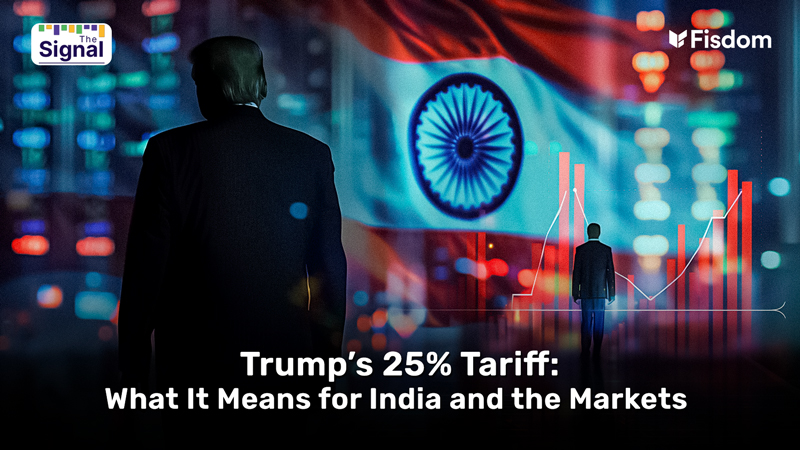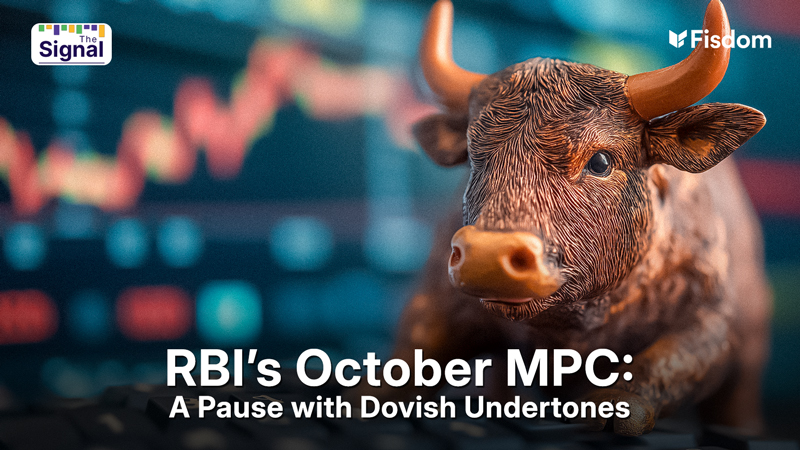
In the past few months, global markets have been rocked by rising policy uncertainty, driven in no small part by President Trump’s erratic trade decisions. One of the biggest tremors came in April, when the US President announced a series of “reciprocal” tariffs—meant to level the playing field, in his words. Though initially paused for negotiations with trading partners, the latest deadline of August 1 passed with a fresh blow to India: a 25% tariff targeting Indian exports.
India Caught in the Crossfire
India had been in ongoing talks with the US to avoid being hit by these duties. But murmurs of a deadlock started surfacing, especially around America’s demand for greater access to India’s agricultural sector. Those rumours turned into reality when President Trump pre-emptively announced the 25% tariff on Indian goods via Twitter—just days ahead of the official deadline. In a further escalation, he hinted at more penalties over India’s continued dealings with Russia.
The development has raised pressing questions: How does this affect India’s economy? What does it mean for investors?
The Market’s Anxiety
In the run-up to the August 1 deadline, markets reacted with visible nervousness. As with any unresolved policy event, the uncertainty loomed large. Institutional investors held back, waiting to see how things would unfold. Data shows that net institutional flows into Indian equities dropped significantly—from Rs. 2,500 crore on July 18 to less than Rs. 800 crore just days before the announcement.
Retail investors, too, turned cautious, dragging indices lower. Since mid-July, the Nifty 50 slipped 1.4%. The midcap and smallcap indices, typically more vulnerable to retail sentiment, fared worse—falling 3% and 5%, respectively.
What the Tariff Means for Trade and Growth
The idea behind Trump’s “reciprocal tariffs” was to counter what he views as unfair trade imbalances. For India, this move significantly dents earlier hopes that the US-China trade war would work to our advantage. Sectors like textiles and electronics were expected to gain market share, given the US’ distancing from Chinese imports. With India seen as a viable alternative under the “China+1” strategy, there was optimism that Indian exporters would benefit.
But that optimism has dimmed. The imposition of a 25% tariff on Indian exports significantly dulls the competitive edge Indian firms were hoping to gain in the US market. Particularly affected could be manufacturers and exporters of textiles, electronics, and auto parts—sectors that had geared up to capitalize on the shift away from China.
Still, not all is lost. The broader “China+1” logic isn’t entirely tariff-dependent. Companies like Apple had already begun moving parts of their supply chain to India, even before this round of trade frictions. Today, India accounts for 44% of US electronics imports, overtaking China’s 25%. So while tariff-related gains might have taken a hit, non-tariff advantages such as geopolitical stability and better IP protections remain in India’s favour.
Limited Economic Impact, But Not Without Noise
It’s worth remembering that India is not an export-led economy. Roughly 60% of the country’s GDP is driven by domestic consumption, while exports account for around 20%. Of that, only a fifth heads to the US. That means the actual economic fallout from this 25% tariff, while headline-grabbing, will be limited. Analysts estimate a GDP impact of just 0.2%.
However, financial markets don’t move purely on fundamentals. Sentiment plays a big role, and that’s where the risk lies. Investors dislike uncertainty more than bad news. When a policy like this is floated, paused, then suddenly implemented, it creates an unpredictable environment, prompting sell-offs and lowering risk appetite.
What Should Investors Do?
Interestingly, markets seemed to brush off the initial impact of the tariff news. On July 31, the Nifty 50 opened 0.9% lower at 24,642 but recovered during the day, eventually closing just 0.35% lower. This resilience was partly driven by a belief that the tariff might still be walked back. Trump himself said, “We’re talking to India now,” suggesting negotiations are ongoing.
This reinforces a crucial point for investors: market volatility, especially in response to political developments, is a feature—not a bug. From trade wars to elections and geopolitical spats, there will always be near-term triggers to shake investor confidence.
Yet, for long-term investors, these episodes often present opportunities. Despite near-term challenges such as tepid private capex and mixed earnings from corporate India, the country’s long-term fundamentals remain intact. Dips triggered by external shocks like tariffs may offer a chance to accumulate quality businesses at more reasonable valuations.
Final Thoughts
President Trump’s tariff salvo may have thrown a curveball, but it’s not a knockout punch for India. The economy’s reliance on domestic demand, ongoing supply chain shifts, and long-term growth drivers make it resilient in the face of such shocks. For investors willing to tune out the noise and stay the course, the path to wealth creation remains very much open—albeit with some short-term bumps.
Market this week
| 28th July 2025 (Open) | 01st Aug 2025 (Close) | %Change | |
| Nifty 50 | ₹ 24,782 | ₹ 24,565 | -0.9% |
| Sensex | ₹ 81,300 | ₹ 80,600 | -0.9% |
Source: BSE and NSE
- The Indian benchmark indices ended lower for the fifth straight week, marking the longest weekly losing streak in two years. Weak global cues and domestic headwinds continued to weigh on investor sentiment.
- Concerns around US President Trump’s 25% tariff on Indian exports, hawkish signals from the US Federal Reserve, mixed corporate earnings for Q1, and persistent selling by foreign investors contributed to the decline.
- On the sectoral front, the Nifty Realty index was the worst performer, sliding 5.7% for the week. Nifty Metal fell 3.4%, PSU Banks dropped 3.2%, and the Media index declined 3%. On the positive side, FMCG stocks offered some relief, with the Nifty FMCG index rising 3%.
- Foreign Institutional Investors (FIIs) extended their selling streak to a fifth week, offloading equities worth ₹20,524.42 crore. In contrast, Domestic Institutional Investors (DIIs) continued their buying spree for the 15th consecutive week, pumping in ₹24,300.05 crore.
- The Indian rupee weakened for the fourth consecutive week, falling by 100 paise to close at 87.52 per US dollar on August 1, compared to 86.52 on July 25. During the week, the rupee traded in a wide range, hitting a low of 87.73 and a high of 86.40, as the dollar index edged closer to the 100 mark.
Weekly Leaderboard
| NSE Top Gainers | NSE Top Losers | ||||
| Stock | Change (%) | Stock | Change (%) | ||
| Jio Financial Services | ▲ | 5.9% | Adani Enterprises | ▼ | -7.8% |
| HUL | ▲ | 5.7% | Wipro | ▼ | -6.4% |
| L&T | ▲ | 4.2% | Kotak Mahindra Bank | ▼ | -6.2% |
| Asian Paints | ▲ | 4.1% | Tata Motors | ▼ | -5.6% |
| Trent Ltd | ▲ | 2.7% | Tata Steel | ▼ | -5.2% |
Source: BSE
Stocks that made the news this week:
Adani Power Approves Stock Split to Boost Retail Participation
Adani Power has announced a stock split, with the board approving the division of each existing equity share of ₹10 into five shares of ₹2 each. This marks the company’s first stock split, aimed at increasing liquidity and making shares more accessible for retail investors. While the stock is up over 15% in the last six months and nearly 10% in 2025 so far, it has seen minor fluctuations recently—rising over 1% in the past five days but falling more than 2% in the past month. The company’s current P/E ratio stands at 17.79.
Eicher Motors Surges After Strong Q1 Results Despite Bearish Outlook
Shares of Eicher Motors rallied up to 4% to ₹5,670 after the company reported a 9% rise in consolidated net profit to ₹1,205 crore for Q1 FY26, along with a 15% growth in revenue at ₹5,042 crore. Despite the upbeat results, Morgan Stanley has retained its Underweight rating on the stock, citing downside risks to margin expectations and setting a target price of ₹4,079—implying a potential 25% decline. The management remains focused on increasing volumes over margins.
Textile Stocks Decline Sharply Amid US Tariff Blow
Indian textile stocks suffered heavy losses for a second day following US President Trump’s announcement of a 25% tariff and additional penalties on Indian exports. The situation worsened after Bangladesh secured a trade deal with the US at a 20% tariff—much lower than the 37% initially proposed—making Indian exports relatively less competitive. Gokaldas Exports, which derives nearly 70% of its revenue from the US, saw its shares fall over 4% on August 1, bringing the two-day decline to nearly 9%.














